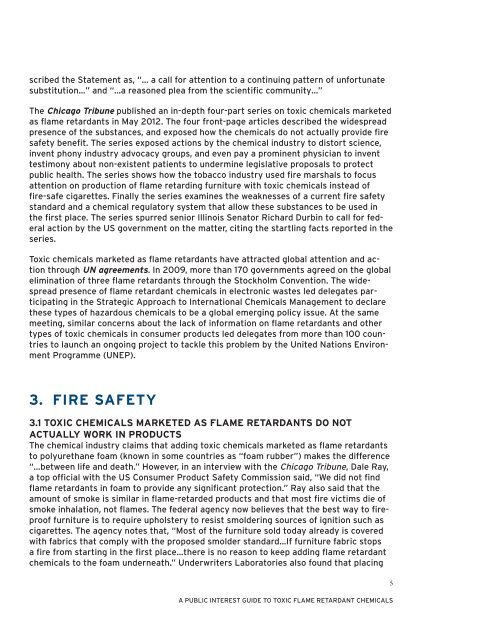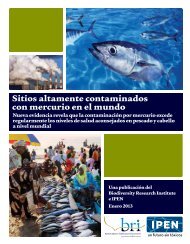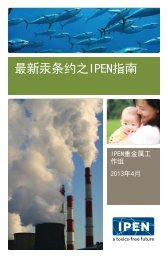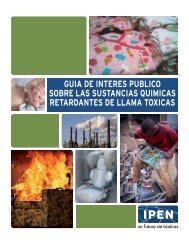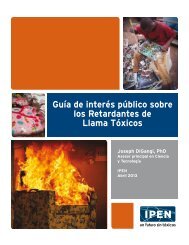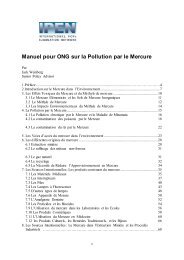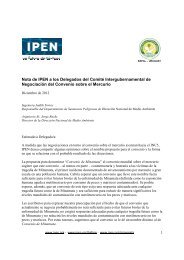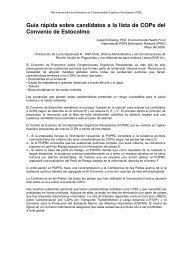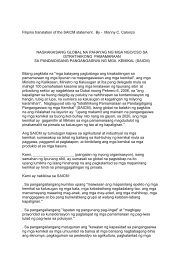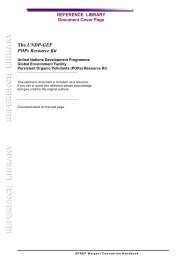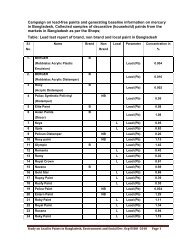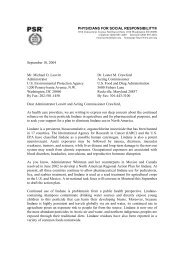A Public Interest Guide to Toxic Flame Retardant Chemicals
A Public Interest Guide to Toxic Flame Retardant Chemicals
A Public Interest Guide to Toxic Flame Retardant Chemicals
Create successful ePaper yourself
Turn your PDF publications into a flip-book with our unique Google optimized e-Paper software.
scribed the Statement as, “… a call for attention <strong>to</strong> a continuing pattern of unfortunate<br />
substitution…” and “…a reasoned plea from the scientific community…”<br />
The Chicago Tribune published an in-depth four-part series on <strong>to</strong>xic chemicals marketed<br />
as flame retardants in May 2012. The four front-page articles described the widespread<br />
presence of the substances, and exposed how the chemicals do not actually provide fire<br />
safety benefit. The series exposed actions by the chemical industry <strong>to</strong> dis<strong>to</strong>rt science,<br />
invent phony industry advocacy groups, and even pay a prominent physician <strong>to</strong> invent<br />
testimony about non-existent patients <strong>to</strong> undermine legislative proposals <strong>to</strong> protect<br />
public health. The series shows how the <strong>to</strong>bacco industry used fire marshals <strong>to</strong> focus<br />
attention on production of flame retarding furniture with <strong>to</strong>xic chemicals instead of<br />
fire-safe cigarettes. Finally the series examines the weaknesses of a current fire safety<br />
standard and a chemical regula<strong>to</strong>ry system that allow these substances <strong>to</strong> be used in<br />
the first place. The series spurred senior Illinois Sena<strong>to</strong>r Richard Durbin <strong>to</strong> call for federal<br />
action by the US government on the matter, citing the startling facts reported in the<br />
series.<br />
<strong>Toxic</strong> chemicals marketed as flame retardants have attracted global attention and action<br />
through UN agreements. In 2009, more than 170 governments agreed on the global<br />
elimination of three flame retardants through the S<strong>to</strong>ckholm Convention. The widespread<br />
presence of flame retardant chemicals in electronic wastes led delegates participating<br />
in the Strategic Approach <strong>to</strong> International <strong>Chemicals</strong> Management <strong>to</strong> declare<br />
these types of hazardous chemicals <strong>to</strong> be a global emerging policy issue. At the same<br />
meeting, similar concerns about the lack of information on flame retardants and other<br />
types of <strong>to</strong>xic chemicals in consumer products led delegates from more than 100 countries<br />
<strong>to</strong> launch an ongoing project <strong>to</strong> tackle this problem by the United Nations Environment<br />
Programme (UNEP).<br />
3. FIRE SAFETY<br />
3.1 TOXIC CHEMICALS MARKETED AS FLAME RETARDANTS DO NOT<br />
ACTUALLY WORK IN PRODUCTS<br />
The chemical industry claims that adding <strong>to</strong>xic chemicals marketed as flame retardants<br />
<strong>to</strong> polyurethane foam (known in some countries as “foam rubber”) makes the difference<br />
“…between life and death.” However, in an interview with the Chicago Tribune, Dale Ray,<br />
a <strong>to</strong>p official with the US Consumer Product Safety Commission said, “We did not find<br />
flame retardants in foam <strong>to</strong> provide any significant protection.” Ray also said that the<br />
amount of smoke is similar in flame-retarded products and that most fire victims die of<br />
smoke inhalation, not flames. The federal agency now believes that the best way <strong>to</strong> fireproof<br />
furniture is <strong>to</strong> require upholstery <strong>to</strong> resist smoldering sources of ignition such as<br />
cigarettes. The agency notes that, “Most of the furniture sold <strong>to</strong>day already is covered<br />
with fabrics that comply with the proposed smolder standard…If furniture fabric s<strong>to</strong>ps<br />
a fire from starting in the first place…there is no reason <strong>to</strong> keep adding flame retardant<br />
chemicals <strong>to</strong> the foam underneath.” Underwriters Labora<strong>to</strong>ries also found that placing<br />
A PUBLIC INTEREST GUIDE TO TOXIC FLAME RETARDANT CHEMICALS<br />
5


